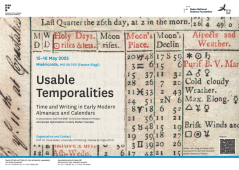This workshop delves into the intersections of time and writing in early modern almanacs and calendars. It aims to analyze not only how these popular and ephemeral texts and chronographic media propagated particular temporal orders but also how they were used. Almanacs and calendars were not merely tools for projecting or tracking (feast) days and celestial events; they were dynamic media in which ‘scientific’ knowledge, practical advice, and cultural (self-)narratives converged. The event brings together interdisciplinary scholars to explore how visualizing and writing practices in these sources framed notions of temporality, and how they mediated personal and collective experiences of time.
Moreover, a central question will be how early modern people adapted and appropriated almanacs, calendars, and similar chronographic media for personal use. In the case of annotated almanacs and (writing-)calendars (Schreibkalender), special attention will be paid to the intertextuality between the printed temporal design and the handwritten notes. Examining this use together with the materiality, circulation, and (inter-)textuality or pictography of almanacs and calendars helps to assess their impact on writing routines and human engagements with time.
By situating these sources within broader early modern practices of timekeeping, record-keeping, and everyday writing, the workshop aims to foster new understandings of the variety of applications of almanacs and calendars as well as their interplay with personal notions of time and (life-)writing.
Veranstaltungsort
Ulteriori informazioni sugli eventi
Informazioni sui costi
